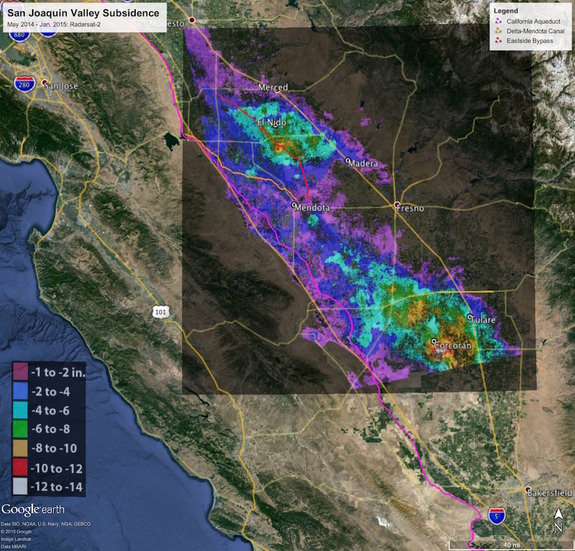The mega drought California is suffering from is forcing the state to pump groundwater at an astounding rate, mostly to support agriculture. Now, officials state that these aquifers could be permanently changed.
Because of increased pumping, groundwater levels are reaching record lows — up to 100 feet (30 meters) lower than previous records,” said Mark Cowin, director of California’s Department of Water Resources. “As extensive groundwater pumping continues, the land is sinking more rapidly, and this puts nearby infrastructure at greater risk of costly damage.”
Certain hotspots are shrinking at an astonishing rate — regions of the Tulare Basin, which includes Fresno, sank 13 inches in just eight months, they found. The Sacramento Valley is sinking about 0.5 inches per month. And the California Aqueduct — an intricate network of pipes, canals and tunnels that funnels water from high in the Sierra Nevada mountains in northern and central California to Southern California — has sunk 12.5 inches, and most of that was just in the past four months, according to the new study.
The unquenchable thirst for groundwater in certain regions is largely a result of agriculture: Most of the state’s agricultural production resides in the fast-sinking regions around some of the state’s most endangered river systems — the San Joaquin and Sacramento rivers. As the heat and lack of rainfall have depleted surface-water supplies, farmers have turned to groundwater to keep their crops afloat.
Subsidence isn’t just an aesthetic problem; bridges and highways can sink and crack in dangerous ways, and flood-control structures can be compromised. In the San Joaquin Valley, the sinking Earth has destroyed the outer shell around thousands of privately drilled wells.
“Groundwater acts as a savings account to provide supplies during drought, but the NASA report shows the consequences of excessive withdrawals as we head into the fifth year of historic drought,” Corwin said. “We will work together with counties, local water districts, and affected communities to identify ways to slow the rate of subsidence and protect vital infrastructure such as canals, pumping stations, bridges and wells.”


No great loss make sure Jerry Brown and Nancy Pelosi are home when it goes under!
Grow my own thank you!
A house built on the sand…
Too logical for democratic party supporters.
This is awful!
Turn the water back on that is just going In to the ocean that is bs we’ve never had a lot of water here it comes form up north we need food stop the bs turn it back on